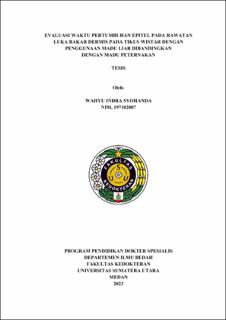| dc.description.abstract | Background: Globally, burns are one of the most common types of injuries. After
emergency management is done, other attention that must be focused is scarring
and healing of the burn itself. The use of honey in burns has been shown in
various literature to reduce inflammatory reactions, accelerate wound healing, and
better infection control, with less chance of causing contractures or hypertrophic
scarring
Method: Experimental research using experimental animals (mice) and using a
post-test control group design. The laboratory rats used were male Winstar strain
Rattus norwegicus species, aged 9-12 weeks, body weight 150-200 grams, types
of food and drink, and the treatment was all conditioned the same.
Results: Day 1 burn area had an average of 194.16 ± 1.72 mm2 in the control
group, 191.67 ± 3.72 mm2 in the Nusantara honey group, 194.83 ± 2.63 mm2 in
the hanuka honey group, 188.5 ± 1.37 mm2 in the wild honey group and 193.5 ±
3.01 mm2 in the silver sulfa group. To compare the results of the examination
with the ANOVA test followed by the Bonferonni post-hoc test. The burn area of
day 21 had an average of 129.5 ± 13.57 mm2 in the control group, 101.5 ± 9.5
mm2 in the Nusantara honey group, 95.67 ± 24.99 mm2 in the hanuka honey
group, 79.66 ± 11.77 mm2 in the wild honey group and 114.67 ± 7.71 mm2 in the
silver sulfa group. The results of statistical analysis showed that the honey group
had clinical significance compared to the control group but the type of honey did
not affect the healing of burns. When compared to the administration of silver
sulfa which was no different from the control, it appeared that wild honey had a
better effect.
Conclusion: The results showed that all three types of honey had clear efficacy
against healing mid-dermal burns judging from the surface area of the wound. | en_US |


